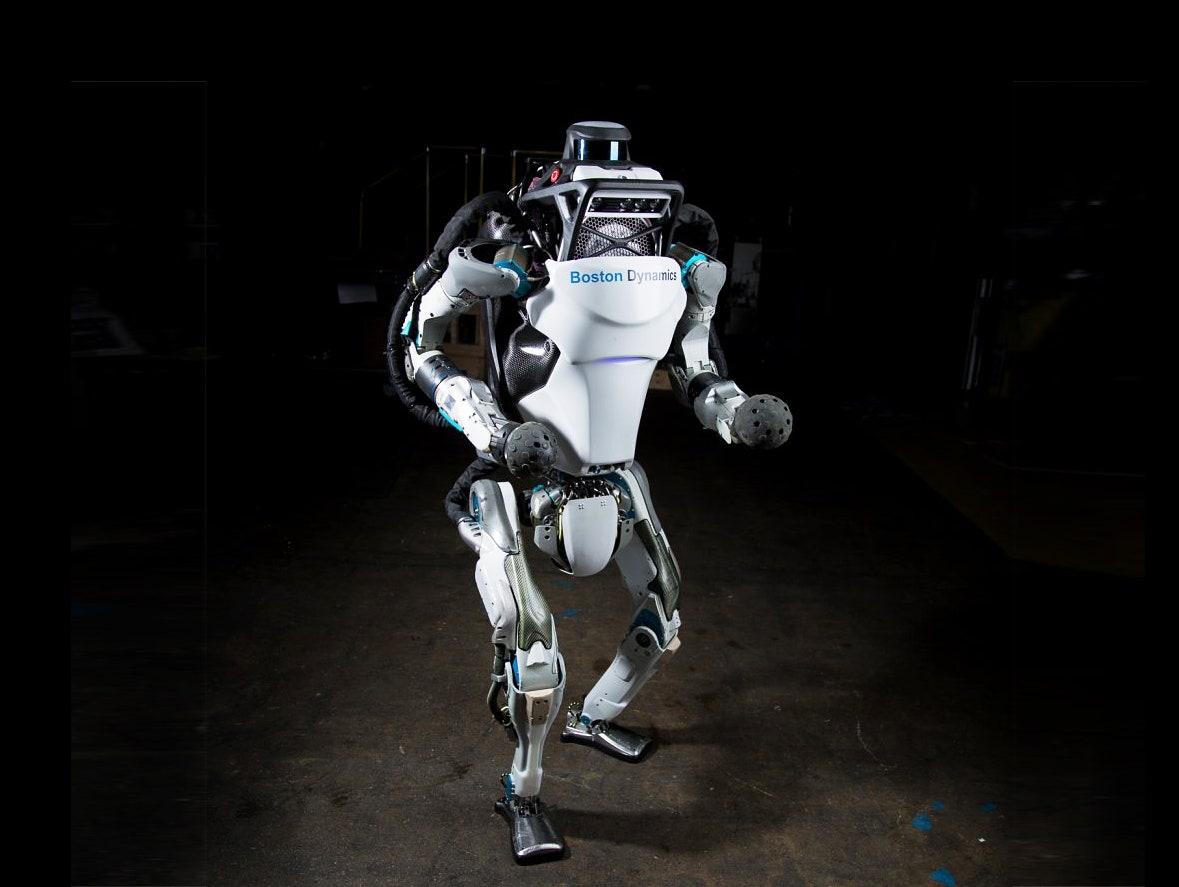5.4.1 The Atlas robot
Course subject(s)
Module 5. Balance in Exoskeletons
In the previous videos, you learned a lot about the balance mechanism in humans and animals, and you have done calculations on the Center of Mass. In contrast to exoskeletons, some bipedal robots are already self-balancing. To get some insight into this, we will look into two examples of bipedal robots. How does balance work in these robots?

Figure: ATLAS, Boston Dynamics
The most famous bipedal robot is ATLAS from Boston Dynamics. ATLAS is specialized for mobile manipulation (meaning that it can coordinate what it sees along with how it’s moving) and can adapt to walking over a wide range of terrain, including snow. It can also do backflips and cartwheels! What about the basics of this robot? The 80-kilo robot consists of 28 joints and has a very complex control system that enables highly diverse and agile locomotion. Algorithms reason through complex dynamic interactions involving the whole body and environment to plan movements. It uses sensors in its body and legs to balance. LIDAR and stereo sensors in its head are used to avoid obstacles, assess the terrain, help with navigation, and manipulate objects (even when the objects are being moved). LIDAR is a method that measures distances and uses a laser to illuminate the target. When reflected, a sensor measures the distance to the target. The differences in laser return times and wavelengths can be translated to a digital 3D representation of the target. All the planning is done in real time.
A lot of people think a robot is a computer that is listening through sensors. But this is only half the story. On the other side, you also got the physics of the world (bouncing, friction, and gravity). Marc Raibert, the founder of Boston Dynamics, said in his TED Talk: “In order to have a successful robot, my religion is that you have to do a holistic design. Where you design the software, hardware, and behaviour all at one time. All these parts really intermesh and cooperate with each other.”
Two mechanisms play an important role in the balance of ATLAS: an accelerometer and a gyroscope. At first sight, you might think it is almost the same, but there is a difference. An accelerometer is an electromechanical device used to measure acceleration forces. These forces can be static, like gravity, or dynamic to sense movement or vibrations. Acceleration is speed divided by time or measurement of the change in velocity over time.
Gyroscopes are also known as angular rate sensors or angular velocity sensors. It is just like our vestibular system like Britt elaborated on earlier. The gyroscope also gives the perception of orientation. Angular velocity is the change in rotational angle per unit of time. How does this work when the robot is moving? For example, when the robot is bending on one side, the sensors of the gyroscope realize that the robot is falling. Immediately a signal is sent to the microprocessor to make the robot balance itself using its motor that is used to control the robot’s movement. Now the joints know exactly what movement they need to make to prevent the robot from falling. This is a general view of the balance mechanism of ATLAS. In reality, it is way more complex than this. What is the main difference between the accelerometer and the gyroscope? One can sense rotation, whereas the other cannot. The gyroscope helps indicate orientation, using the key principles of angular momentum. The accelerometer, on the other hand, measures linear acceleration based on vibration and movement.
Sources:
- Meet Spot, the robot dog that can run, hop and open doors | Marc Raibert. (2017, August 14). [Video]. YouTube. https://www.youtube.com/watch?v=AO4In7d6X-c&feature=youtu.be
- Brain, M. (2020, June 30). How Gyroscopes Work. HowStuffWorks. https://science.howstuffworks.com/gyroscope.htm
- Wikipedia contributors. (2020, September 1). Humanoid robot. Wikipedia. https://en.wikipedia.org/wiki/Humanoid_robot
- Wikipedia contributors. (2020, July 28). Atlas (robot). Wikipedia. https://en.wikipedia.org/wiki/Atlas_(robot)
- Atlas® | Boston Dynamics. (2020). Boston Dynamics. https://www.bostondynamics.com/atlas

Project MARCH: behind the technology of robotic exoskeletons by TU Delft OpenCourseWare is licensed under a Creative Commons Attribution-NonCommercial-ShareAlike 4.0 International License.
Based on a work at https://online-learning.tudelft.nl/courses/project-march-behind-the-technology-of-robotic-exoskeletons/



